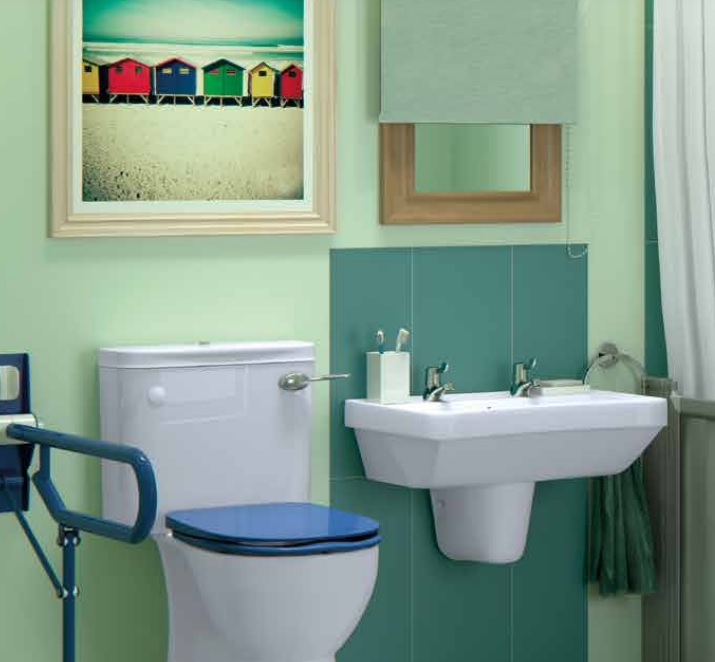We highlight the importance of product choice when choosing toilets for dementia-friendly settings

For most people bathrooms are not particularly-confusing places, but for someone with dementia what was a once-familiar environment can suddenly become difficult to navigate, particularly if the person has moved to a hospital or care home.
Accessible bathroom manufacturer, AKW, recently-published its Guide to Creating a Dementia-Friendly Bathroom, which highlights something that, for people with dementia, using the bathroom is an everyday battle.
But a few simple design tools can help to relieve the anxiety associated with this.
The document states: “A dementia-friendly bathroom is one where simple-but-careful consideration of design can reduce the barriers that people with dementia can face in carrying out daily living activities, greatly improving their safety and preserving their independence for as long as possible.”
Keep it familiar
And it advises: “Choose familiar-looking controls, not push-button or infrared ones as modern devices can be confusing for people with dementia.”
This is an approach supported by experts at the University of Stirling’s Dementia Services Development Centre (DSDC), who state in their own design guidance: “While short-term memory is impaired, people with dementia usually retain good long-term memory and may be more comfortable with traditional fixtures and fittings, rather than modern designs.
“Products designed for users with dementia don’t cost any more than those needed for a standard adaptation. However, it is imperative that the right products are selected, following the guidelines carefully to maximise safety and comfort for residents with dementia.”
This familiarity is absolutely key for all dementia design.
And, when specifying dementia-friendly toilets, one of the most-important elements is the flush.
Perhaps the most-well-read guidance comes from dementia design pioneer, Professor Mary Marshall.
In her report, Toilet Talk, she states that, when choosing toilets for dementia-friendly environments the choice of flush is crucial as if someone can’t flush the toilet they can feel embarrassment and become frustrated, leading to increased anger and aggression.
“Flush systems are becoming ever more complicated,” she says.
“The first problem is understanding how they work.
“Some require you to wave your hand in front of a sensor. These are often incomprehensible to many people, and signage rarely helps.
“Others require considerable hand strength to push in, and some flush automatically when the person rises from the toilet, which can be very confusing to the user, particularly if they have dementia.
Colour counts
“Water conservation flushes that provide two buttons can also be confusing.
“The answer is simple: A visual lever.”
It’s also important to consider toilet type.
Marshall says: “Some toilets have the cistern behind a facia, which means this cue to the flush arrangements is not available.
“Painting the outline of a cistern on the facia can help in this case, but avoiding the use of hidden cisterns is more advisable.”
And using colour can help to distinguish between the toilet and other surfaces and products within the bathroom.
A coloured toilet seat, for example, can have a very-positive impact, reducing confusion and even helping to combat incontinence.
Lynda Hutton, a learning and development officer with experience working in care homes, has provided comment in the DSDC’s Products for Dementia guide.
She says: “Simple changes to a person’s living environment can make a huge difference to quality of life.
“Having a range of products available which are familiar and easily understood by older people living with dementia can be life changing.
“Coloured toilet seats, for example, can help an individual to navigate their surroundings, provide dignity, and promote wellbeing.”
AKW’s own research confirms that making the toilet a different colour to the wall, and the seat a different colour to the rest of the toilet, can have a significantly-positive impact.
And it doesn’t have to be red!
Despite most dementia-friendly environments favouring red as a stand-out colour; evidence suggests that as long as there is good contrast – a difference of 30 LVR – then any colour works.
Good dementia-friendly toilets also need to have traditional toilet roll holders and grab rails installed, again in highly-contrasting colours so they can be easily identified.
“Ideally, it’s good to position the toilet so it can be seen from the bed – something that is especially important in nursing homes which may be a unfamiliar environment for people with dementia,” states the AKW guide.
AKW’s head of product and marketing, Stuart Reynolds, adds: “Eradicating confusion is the aim of dementia-friendly design.”